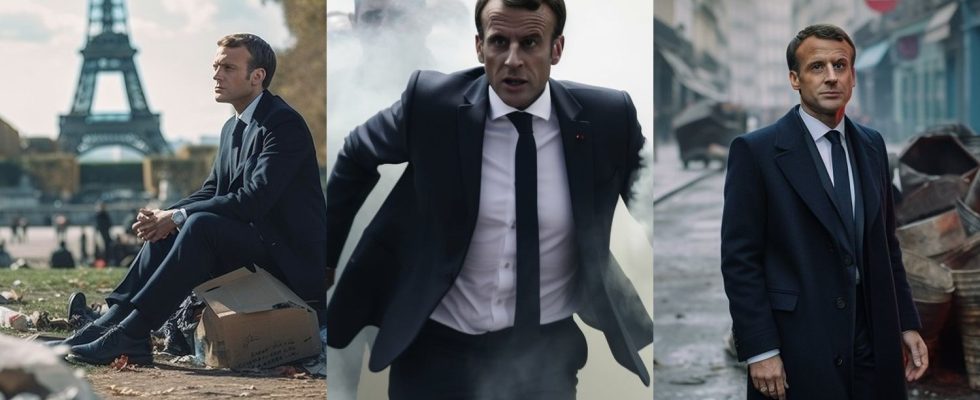Emmanuel Macron sitting on piles of garbage in front of the Eiffel Tower, or in a suit and orange waistcoat picking up trash in the midst of a garbage collectors’ strike against the pension reform, or with CRS in the smoke of tear gas or even Emmanuel Macron arrested by law enforcement… These images have been shared dozens of times on social media. The scenes, improbable, were created by an artificial intelligence and rather made people smile. But at the same time, they raise questions through their increasingly advanced realism, because they represent a risk of misinformation.
I’#ia #photo has made insane progress in a very short time, now the #fake will be the standard on #networksdoubt what you see by default, more choice.#midjourney #midjourneyv5 pic.twitter.com/dJoZXGrbRy
— Cryptonoo₿ From 100K to 0 (@Cryptonoobzzzz) March 19, 2023
More and more realistic fake photos
These images were all created by Midjourney, an artificial intelligence (AI) developed by an American independent laboratory and launched in July 2022, initially to create digital works of art. Its operation is simple: any Internet user can connect to Midjourney’s “living room” on the Discord social network and ask him to invent a fake photo for him by saying, for example, “Emmanuel Macron sitting on a pile of trash cans in Paris” . The AI will then look for details in the billions of real images that are available on the internet to group them together and invent a fake one corresponding to the order.
In the same vein, we have also seen fake photos of former US President Barack Obama and former German Chancellor Angela Merkel together at the beach, eating strawberries or making sand pies. Or a picture of Pope Francis in a big white down jacket.
Donald Trump’s false arrest sows doubt
But it was false images of Donald Trump surrounded by police, being arrested, that really caused trouble. They were requested from Midjourney by Eliot Higgins, the founder of Bellingcat, a news NGO specializing in online investigation and verification. He then posted them on Twitter on Monday, March 20 with the message: “Making images of Trump being arrested while awaiting his arrest”.
Making pictures of Trump getting arrested while waiting for Trump’s arrest. pic.twitter.com/4D2QQfUpLZ
— Eliot Higgins (@EliotHiggins) March 20, 2023
The journalist was referring to statements by former US President Donald Trump who had announced that he was to be arrested the next day, Tuesday March 21, for having bought the silence of porn actress Stormy Daniels. The arrest did not actually take place but the fake images were widely shared on social media and viewed millions of times. From sharing to sharing, the origin of the images has been lost and several Internet users have believed that they were really photos of the arrest of Donald Trump. A joke at first quickly turned into misinformation.
Still inconsistencies in details and backgrounds
So how do you recognize images created by artificial intelligence? For the moment, these images are not yet perfect, there are visual inconsistencies that can be spotted.
First, you should know that with AI, the devil is in the details. Take the image of Emmanuel Macron sitting in front of garbage cans and men in uniforms, reading a newspaper. If we zoom in and look closely, we see that his right hand is a bit weird, his watch is not very regular, his eyes are the wrong color, his facial features are a bit cartoonish, and his skin has looks like it was drawn. The newspaper he seems to be reading is not written in French.
My contribution, with Midjourney V5 pic.twitter.com/5X0FART8t5
— Raphael Grably (@GrablyR) March 22, 2023
AIs also tend to botched backgrounds. In this image, behind the President of the French Republic, there are men in black uniforms and yellow helmets, but this yellow does not match any helmet of any French law enforcement or firefighters. None of these men have shadows and the background is still very blurry, with some curved lines. Another example: in an image representing Angela Merkel and Barack Obama at the beach, a man in the background has only half his legs and no feet.
Thanks to these observations, for the moment, we still manage to see that these images were invented. “However, the AIs are improving day by day and showing fewer and fewer anomalies, so visual cues should not be relied upon in the long term”, warned Annalisa Verdoliva, professor at the Frederick II University of Naples, to AFP. The search for new tools is a real challenge in the fight against disinformation.
Controversies in the art world
But Midjourney and the other AIs also pose other problems revolving around the question: what is a work? The Inrocks report that in August 2022, a painting designed by Midjourney won an award in the “Emerging Digital Artists” category in the United States. The jury didn’t know it was an AI-created image when they selected it, they believed it was made by a man, Jason Allen, on digital software. The case created controversy.
Last February, new controversy. Another image created by an AI has won a small Australian social media photo contest, according to Numerama. The same month, in the United States, the US Copyright Office decided to remove copyright protection from a comic book because its author had used Midjourney. Kristina Kashtanova is recognized only as the creator of the texts but not of the drawings.
And the controversies have just invited themselves in France. On Sunday March 26, the newspaper Le Figaro illustrated one of its articles with an image created by Midjourney, as can be seen in this archived version of the web page. Several Internet users have noticed it. Some were moved, denouncing the fact that the media would be able to illustrate their articles for free, without having to pay an illustrator or a photographer. The image was finally changed a few hours later.
